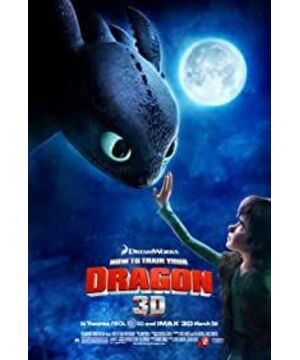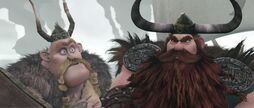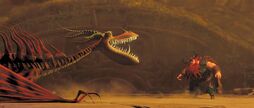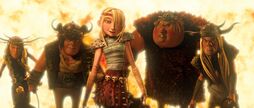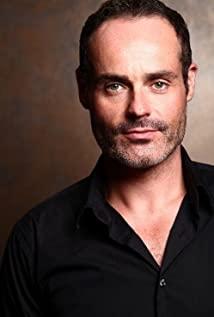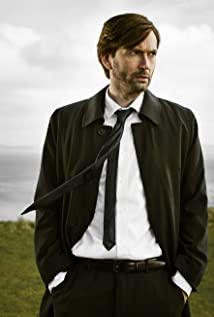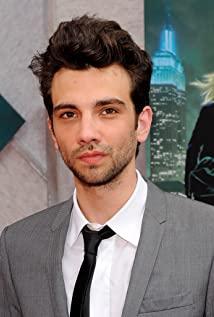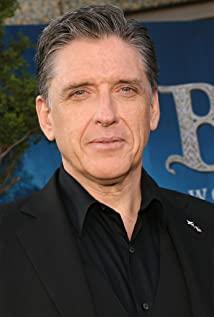"How to Train Your Dragon" is a 3D movie that I recommend after "Avatar". The details of the picture are full, the texture is transparent, the depth of field is distinct, and there is no sense of abruptness. The mountains, seas, and earth presented in the film, the textures are as lifelike as real objects, and the dynamics of clouds, fog, wind and waves are captured and reproduced in detail. The colors are based on cold tones (blue, dark blue, green), and then blended into warm tones (red, yellow, orange), to create a sense of warmth and gentleness in tranquility, which makes the viewer feel happy and relaxed. The sculpting movements of the little dinosaur are very lively and funny, and it will feel distressed when it is hurt. Although the little dinosaurs were not very cute at first glance, but after pleasing to the eye, they fell in love. The big scenes in computer animation are easier to control and present the desired visual effects than in live-action movies. As long as the corresponding fidelity is produced, the audience will be amazed and fully engaged. With the current computer technology, this kind of picture processing is not a problem, and the limitation is only in the aesthetics of the producer. There are a few shots of a burning ship in the film, and I feel that the production is better than "Chibi", and "Chibi" was simply filmed with computer animation. At the end of the play, it turned out that Roger Deakins* was the visual effects consultant for this movie. The movies checked by Roger Deakins really have first-class visual quality (he is also Wall-E's visual effects consultant).
As far as the story is concerned, the theme of the film's growth is not new, and the plot is not surprising. But the lack of a twist in the plot does not mean that a good movie cannot be made, because as long as it can bring out the feelings of people, a movie can be said to be complete. The most touching thing about this movie is that it makes me indulge in the dream of riding the wind and waves, through the clouds and fog, soaring in the sea and sky. (Oh, I know you think of "that movie", but don't mention "that movie", let it rest in peace.) Everyone has a dream of flying in their hearts, maybe it was crushed under the great wheel of the years , Buried in the deepest corner of the soul. You think you have forgotten it, but when you see a possibility, it will still run through your soul like an electric current, letting you fly in a dream again. You said, this kind of picture is not the first time it appears in a movie. Well, I admit that when I was watching a movie, I was affected by the screen and I was particularly touched. The point is, this animation made me feel good from the beginning, and this good impression lasted until the end. A kind of private movie-watching feeling, it really cannot be treated rationally.
"How to Train Your Dragon" at the beginning of the battle between humans and dragons is very interesting, the rhythm is handled calmly, without the horrible taste of life and death, flesh and blood, but brewing the drama of gentleness. Although it is a big battle, its focus is not to use sensory stimulation to gather the audience's attention, but to have an important narrative effect. This war is based on the interaction between Hiccup and the people around him. From the beginning, it clarifies the Mao Dun between the dragons and the dragon, the troubles Hiccup faces, the perception of Hiccup by the people around, and the dream lover of Hiccup, and all the characters in the play are brought out. The main character also buried the fate of Hiccup and Toothless (little dinosaur) later meeting. The design of the opening sections was obviously thoughtful, telling the audience these messages almost invisible, and laying the groundwork for the future plot development from the beginning. After the dinosaur attack is over, the audience has a concrete grasp of the relationship between the characters and Mao Dun, and the plot unfolds smoothly without feeling a bit far-fetched. The skill of the screenwriter was demonstrated at the beginning.
There are three relationships surrounding Hiccup, namely the relationship with Toothless, the relationship with his father, and the relationship with the dream lover Astrid. Among them, the relationship between Hiccup and Toothless is naturally expressed in the most space. For the handling of these three relationships, although some simple plots are used to portray them, the details can contain feelings. As my personal opinion mentioned earlier, a movie with sentimentality is better than a movie with a circuitous plot, so this movie is quite useful for me. Hiccup and Toothless finally ran into each other through many conflicts, which is very heartwarming for the emotional establishment of master and servant. The love between Hiccup and Astrid is more fresh and direct. From the very beginning, Hiccup puts love in the bottom of his heart. Later, when Astrid kissed Hiccup after flying, and even later, Astrid's support and encouragement to Hiccup were never experienced. A lot of pretentiousness, on the contrary, there is an innocent moving force. As for Hiccup and his father, it is a typical story in which the adult’s stubbornness and dominance obliterated the innocence of the teenager, made a big mistake, and finally released the suspicion. Although his hometown wishes, his love is sincere.
If there is no suspense in this movie, it is not at all. For example, I can't guess how Hiccup and Toothless fought an impossible war. At the end, I couldn't help laughing. The screenwriter was really bewildered. It turned out to have revealed the mystery earlier. It turned out that I was going to sell it. This proves once again that the skill of the screenwriter is quite extraordinary. The last battle was quite catching, especially the diffuse smoke and dust flying after the explosion, vaguely revealing an ominous tragedy, which made the slave family's heart uncontrollable. Tugging, screaming, brother, you can't die... the
movie also has a bit of anti-war meaning. The eyebrow scripts recorded in the "Dragon Manual" are all "seeing to kill". The whole book is full of prejudice, and Hiccup sighs that everything is wrong after reading it. Wars and vendettas are caused by prejudice, which is a good introductory education for children. Although, adults all know that there are complex stakes behind the war in reality. The prosthetic limbs that appear in the movie are also a kind of accusation against war: war does the same damage to both the enemy and ours.
View more about How to Train Your Dragon reviews


